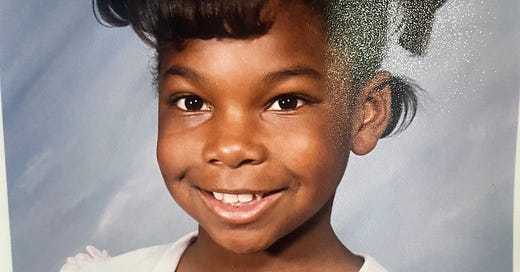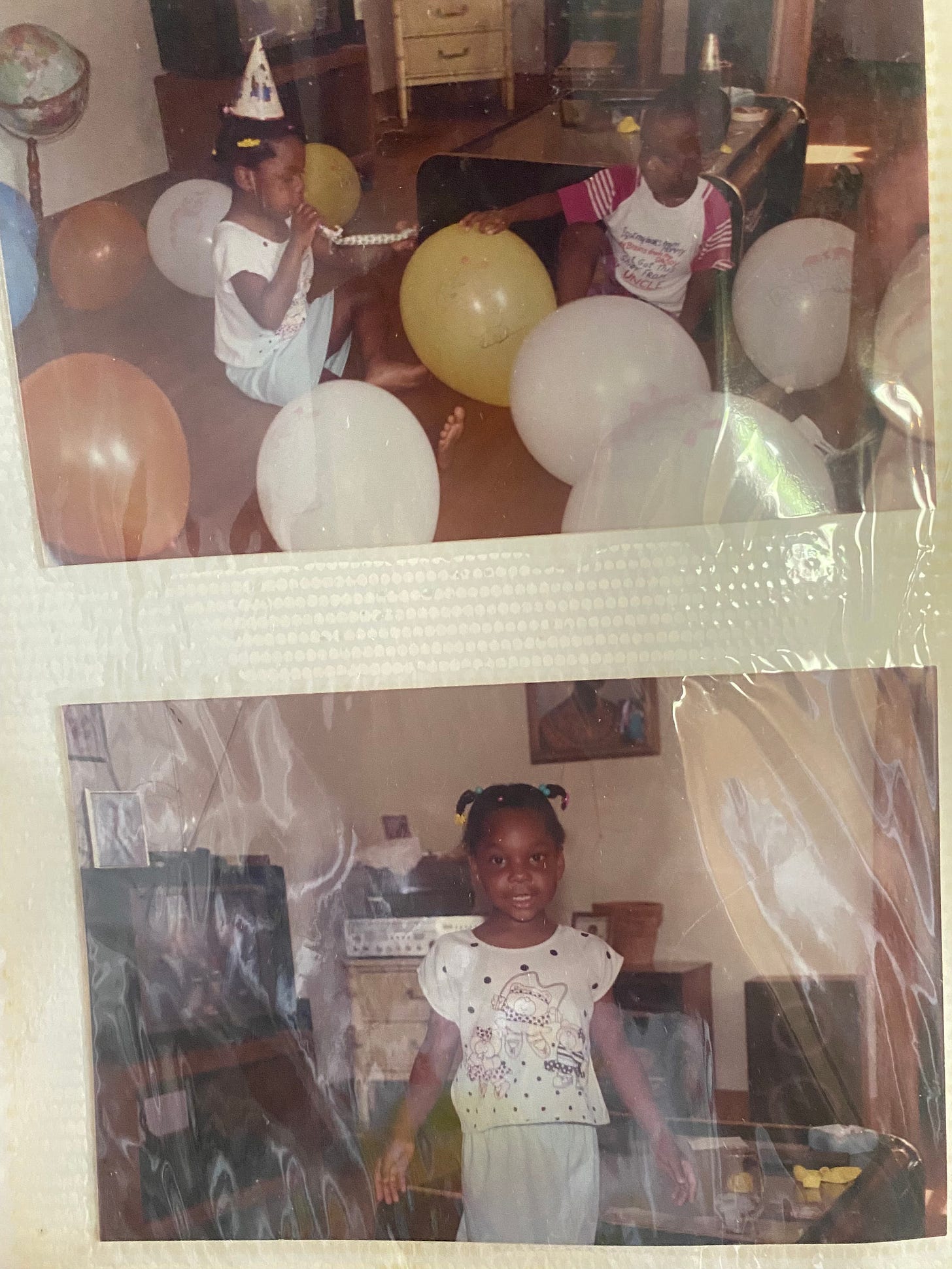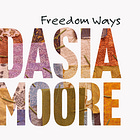When Books Become a Container of Possibility for Black Girls
Emma Akpan on how books became both refuge and revelation for a Black girl seeking her place in the world.
If someone forwarded this to you, subscribe here! If you want to get in touch, email here!
Freedom Ways is an interview & essay series exploring the intersection of artistry and liberation, illuminating how art serves as both personal transformation and collective resistance. This Freedom Ways essay, in collaboration with , features Emma Akpan.
is a writer who lives in Washington, DC, and was born in Toledo, Ohio. She is working on a collection of short stories about women encountering gentrification and technological changes in Washington, DC. She writes about girlhood, the unsaid, fugue and paths of escape, and agency for the powerless. She also writes about religion and reproductive rights, and visual arts and culture.
When Emma is not writing, you can find her on a yoga mat, taking pictures, or making floral arrangements.
Emma has attended Tin House Workshop and Sackett Street workshops, and is a scholarship recipient for Blue House Residency. She is a 2025 Kimbilio Fellow. Her writing has appeared in New City Arts, Cultbytes, Reckon Magazine, Kord Backstage and Rewire News.
—
I cannot remember the origin of my writing practice. I do remember reading stories like the Bobbsey Twins and Beezus and Ramona, and then pulling out a notebook to make up a story about Sally who went to the store to buy apples. I remember listening to sermons in church, savoring the repetitive structure, and writing a speech about Martin Luther King for a seventh grade contest. I walked into public libraries, hand in hand with my mother and sister, piling stacks of books in our bags, studying my mother as she draped at least three upturned books on the arms of couches. A ritual.
I wanted to write because I found identity in books.
And when preparing to write this essay, I again turned to books.
Edwidge Danticat writes in We’re Alone, “It is much easier to explain or elaborate on endings than beginning. Beginnings have more amorphous origins.” She goes on to explain that when she needs a beginning, she starts with her earliest childhood memories: a four-year-old in an airport, torn from her mother’s leg before her mother boards a flight to New York. She is left standing with her uncle, floor vibrating next to her while her brother thrashes, crying, and her mother hurries away so she isn’t tempted to engulf her children in an embrace and remain in Haiti.
I read this passage, searching and not finding that one moment defining the theme of my writing practice. Danticat writes frequently about immigration and loss of parentage, often from a child’s perspective. With this origin story, the reader sees clearly Danticat’s thread from spark to fully realized themes. However, my own childhood wasn’t a series of discrete formative moments propelling the “spark.”
I read The Boxcar Children by Gertrude Chandler Warner. The four Alden kids, orphaned and homeless, discover an old boxcar in the woods and make it a home. The eldest sister makes it comfortable with found fabrics, the brothers forage for food. It’s an adventure. My own childhood lacked adventure, characterized by confinement instead. I couldn’t walk in the living room in the middle of the night for a snack without my mother waking to ask me what I was doing. I dreamed of far-off lands, being abandoned in the woods, packing a bag and walking away. The children’s wealthy grandfather discovers them in the woods and rescues them, ushering them into his picturesque home with wide spaces fit for children’s play. They recreate the woodland adventures of the Boxcar–this time with the security of a room and warm meals and the charge of an adult. My two selves, writer and not writer, are distinct, but indistinguishable, because poor Black girls exist perpetually in our dreams.
My writing serves as a container for those dreams.
Reading helps to chart the possibilities of my dreams.
"My two selves, writer and not writer, are distinct, but indistinguishable, because poor Black girls exist perpetually in our dreams. My writing serves as a container for those dreams.”
The Stoning of Soraya M. is a 2009 film about a small Iranian village where a group of men stone a woman falsely accused of infidelity. Soraya M. is a thirty-five-year-old wife to the abusive Ali, who wants to divorce Soraya so he can marry fourteen-year-old Mehri. Soraya refuses the divorce, which would leave her and her children in poverty. Ali can only get rid of her if she is killed, so he falsely accuses her of adultery, punishable by stoning. Ali turns the village against Soraya with ease, a culture of misogyny and mistrust of women making everyone readily believe that she is sleeping with the man employing her. Ali turns Soraya’s two sons against her. A journalist’s car breaks down in the village, and Zahra, Soraya’s aunt, tells him of her stoning. The men of the village try to prevent the journalist from leaving with the tape Zahra has created, but Zahra slips him a copy while he is seated in his car, and he drives off, tape in hand, ready to release to the public.
The woman tells the men of the village, “What are you afraid of? Justice was served, wasn’t it? The God I love is great. Wasn’t our village going to be an example for the rest of the country? Now the whole world would know. Yes! The world will know what happened here!”
***
My life has been a series of isolated incidents that happened only to me, or so I thought.
In Nobody Knows my Name, James Baldwin writes an essay entitled “Notes for a Hypothetical Novel,” addressing a group at San Francisco State College in 1960, and conjures an theoretical novel he would write for the group. He says, “Let’s pretend that I want to write a novel concerning the people or some of the people with whom I grew up, and since we are only playing, let us pretend it’s a very long novel.”
"You think your pain and your heartbreak are unprecedented in the history of the world, but then you read. It was books that taught me that the things that tormented me most were the very things that connected me with all the people who were alive, who had ever been alive.” - James Baldwin
I’ve started writing like this. I want to write a story about men who stand outside all day. I want to write a story about a poster in my sister’s bedroom. I want to write a story about dust, the dust that floats in the afternoon sun streaming from an open window. I want to write something concerning some of the people I notice.
These portraits, at times, swell into a full story. Other times they are vignettes.
When I was a second-year seminary student, we were assigned Go Tell it on the Mountain for a theology class, or maybe it was American Christianity. My older sister had died the year prior. I ignored my grief for a year. I hoped God would help me forget. God didn’t. Grief caught me in a hallway outside of class. I heaved. My sadness clutched my heart like a squeeze. I was falling. A fellow student, dreadlocked with warm, small hands led me into the bathroom so I could breathe before the class.
Afterwards, I felt stupid. Evolutionary science says that crying publicly is a sign that you need care, empathy or help. Still, I felt stupid.
I found a therapist soon after that incident. I didn’t want to be embarrassed anymore.
I told my therapist how ashamed I was over the incident. She asked why, adding, “There is nothing wrong with crying.” I said, “But I feel like a child.”
While reading Go Tell it on the Mountain, I came upon the character of Gabriel reflecting on a drunken night with a harlot, mired in lust:
And his tears began—such tears as he had not known were in him. ‘I wept,’ he said later, ‘like a little child.’ But no child had ever wept such tears as he wept that morning on his face before Heaven, under the mighty tree. They came from depths no child discovers, and shook him with an ague no child endures. And presently, in his agony, he was screaming, each cry seeming to tear his throat apart, and stop his breath, and force the hot tears down his face, so that they splashed his hands and wet the root of the tree: ‘Save me! Save me!’
I read this passage aloud, sitting across from my therapist. She nodded. Asked, “How does that make you feel?”
I felt as if the ground had opened for me, but instead of being swallowed whole, I landed softly into a cloud of people who’d also lost a loved one. I felt I was too young to join the underground, but grateful I found countless others whose grief dug into our souls. Now when I fall, I fall among company.
***
In writing, it is possible to be necessary. In How to Write an Autobiographical Novel, Alexander Chee has an essay entitled, “100 Things About Writing a Novel.” He writes, “Everyone has a novel in them, people like to say. They smile when they say it, as if the novel is special precisely because everyone has at least one. Think of a conveyor belt of infant souls passing down from heaven, rows of tired angels pausing to slip a paperback into their innocent, wordless hearts.” I have a novel in me.
I felt as if the ground had opened for me, but instead of being swallowed whole, I landed softly into a cloud of people who'd also lost a loved one. I felt I was too young to join the underground, but grateful I found countless others whose grief dug into our souls.
What exactly does that mean? Yes, we all have stories. A novel is much more than a story we retell, or a string of events we can write down. It is a crack in our heart, and sometimes we must bleed to release it. It asks us to question our deepest, sometimes shameful desires, write down our harmful impulses, and put into words the people and places that exist amorphously in our nightmares.
So, it’s in you, sure. But the novel is not going to saunter into your room, sit down next to you, and tell you what to say. It may even bite or snarl at you, or disappear for years and reappear without warning.
I thought the beginning of my first novel walked into my room and sat down one day. My mother says about her growing up, “I had an idyllic childhood.” Idyllic? An idyllic childhood growing up poor in the Rust Belt in the 1950s? How? When she said this, I thought, I have to prove her wrong.
I’m going to write a novel. The novel will be about an all Black neighborhood torn down by the city to make way for a new expressway. In the novel, the Black people will be destitute. They will fear the “Big Bad” of eminent domain that will take their homes and neighborhoods for I-475. The neighborhood will have conversations in hushed tones. Some characters will protest, but most will begin packing. Mothers, sad because their daughters moved away. Mothers, sad because their daughters are pregnant and unmarried. Children waking up to no presents at Christmas. Mothers, sad because they’ve had to move quickly, and lost golden frames with their grandmother’s only photo surviving the journey north from Arkansas or Louisiana.
I’ve begun my research. I found a newspaper article about other children growing up in Toledo in the 1950s. I found a 2018 quote from Twyla Wheaton, who is about ten years older than my mother. Here she is, as quoted in the article:
“I am a native Toledoan. I was born here and I lived here all my life,” Ms. Wheaton, a retired Toledo Public Schools teacher, said. “I personally did not run into a lot of segregation or discrimination maybe because I lived in all-black neighborhoods. It’s the accomplishments of black people in Toledo that interest me very much.”
The novel about Black grief in a Rust Belt city got up and walked right out of the room. Sometimes I personify the novel as a woman. I glimpse her, well dressed, running into the grocery store, but she buys her canned tomatoes and frozen chicken wings and floats out, catching my eye, a smile that says, I see you.
Telling stories—whatever the point, the message, the politics, the lesson, the axiom or the action—shouts, 'I am human. I am here. I see you too.’
When thinking of my writing practice, and considering why I began writing, I realized I couldn’t answer the question without a little help. I pulled out most of the books I own about writing to weave this together.
James Baldwin once said, “You think your pain and your heartbreak are unprecedented in the history of the world, but then you read. It was books that taught me that the things that tormented me most were the very things that connected me with all the people who were alive, who had ever been alive.”
I’m connected to humanity. Telling stories—whatever the point, the message, the politics, the lesson, the axiom or the action—shouts, “I am human. I am here. I see you too.”
Related reading
Thank you for reading this edition of Freedom Ways. Become a paid subscriber, share us on social media (if you please) or Substack notes!











![Submissions | Writing a Liberatory Practice [A Lit Lib x Memoir Land collaboration]](https://substackcdn.com/image/fetch/$s_!gfBY!,w_140,h_140,c_fill,f_auto,q_auto:good,fl_progressive:steep,g_auto/https%3A%2F%2Fsubstack-post-media.s3.amazonaws.com%2Fpublic%2Fimages%2Fa9a39cd6-0ccd-471f-bc77-cd4e10a03dcb_1200x800.heic)

I was such a bookworm growing up. still am, though these days i am enthralled more with history more than fiction. I wasn't a child who used many words but I was full of them. books let me live in worlds beyond mine. today i am trying to do the work of returning back to my world that books let me take respite from. i loved the idea of books serving as reminders of our collective humanity, of our not alone ness, even though the act of reading seems very solitary. i am thinking about how i can archive my stories, and become a part of our ancient storytelling tradition. writing has become a site of overthinking lately. but what if it just served as a witness to my humanity? what if I simply took the invitation to join the conversation?